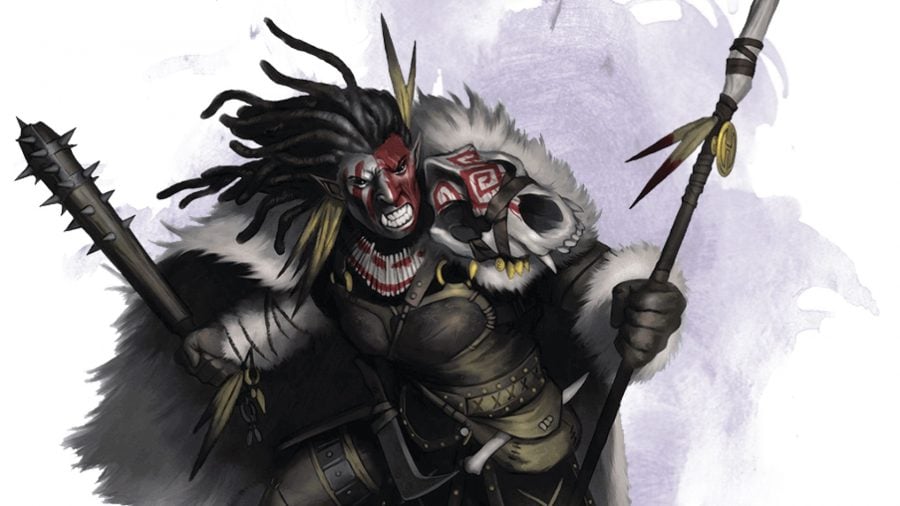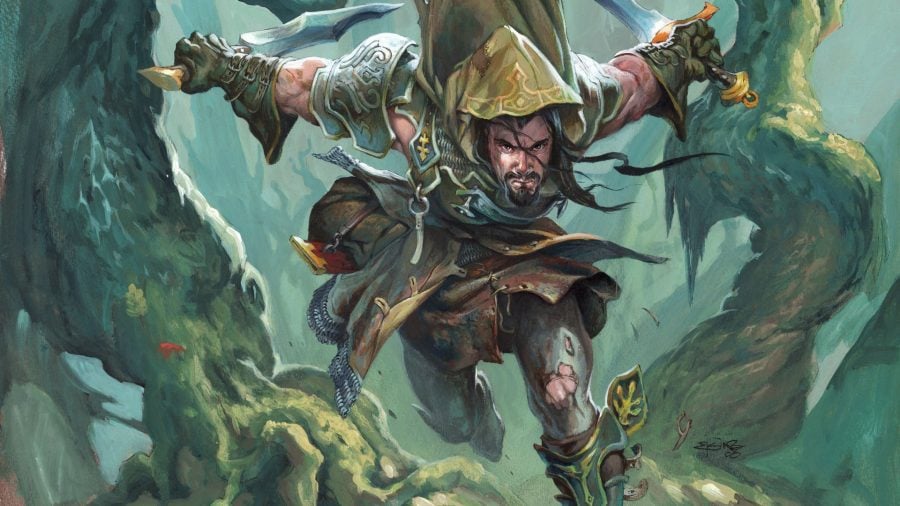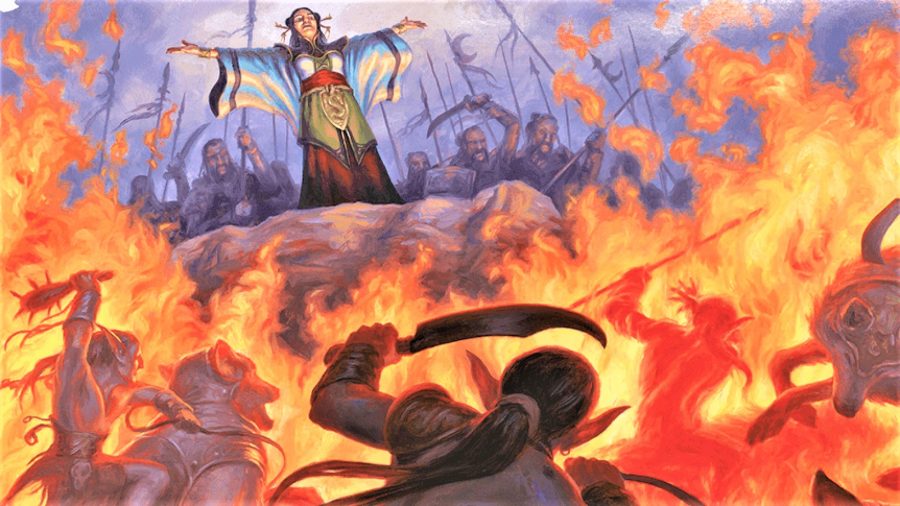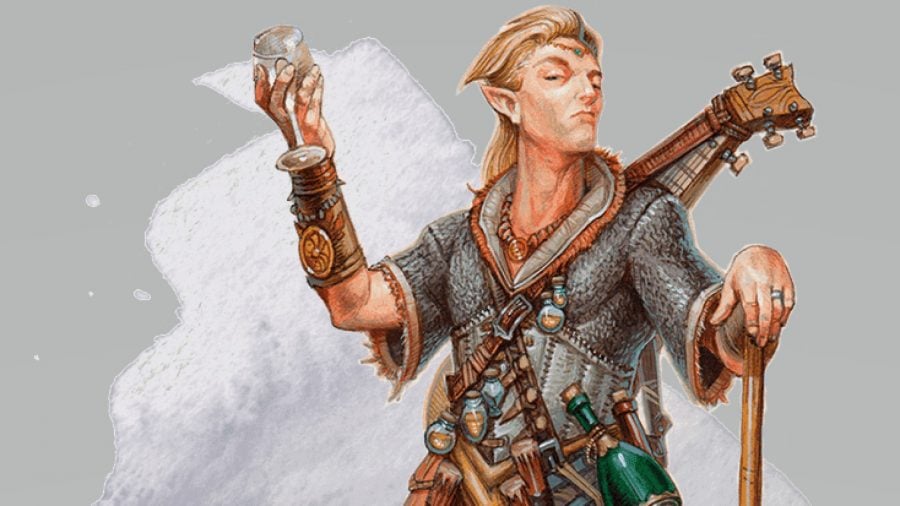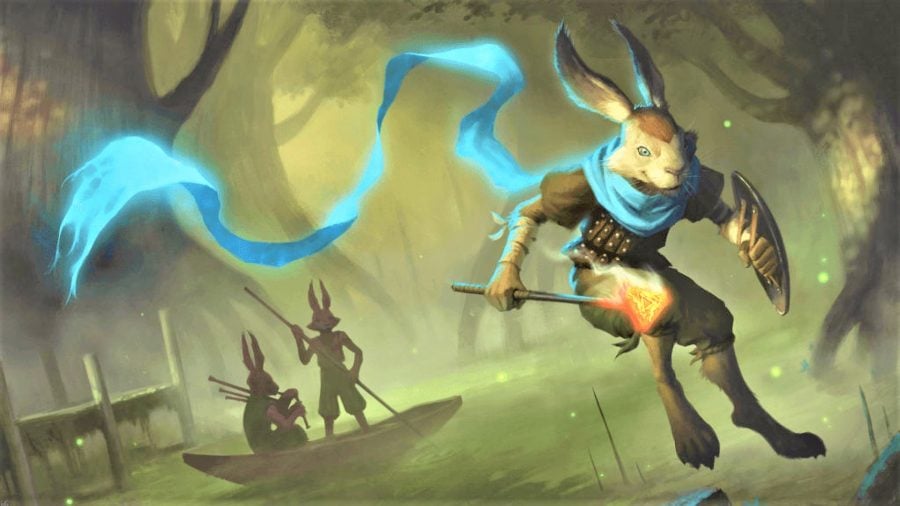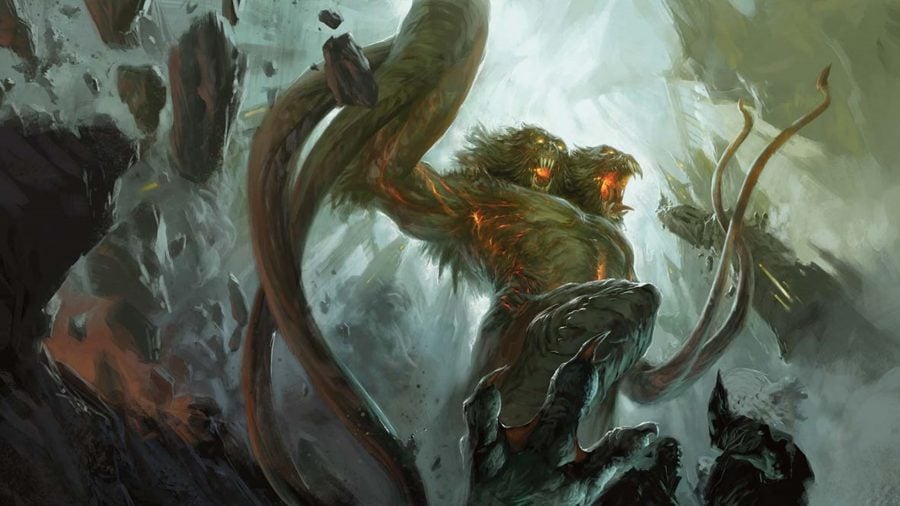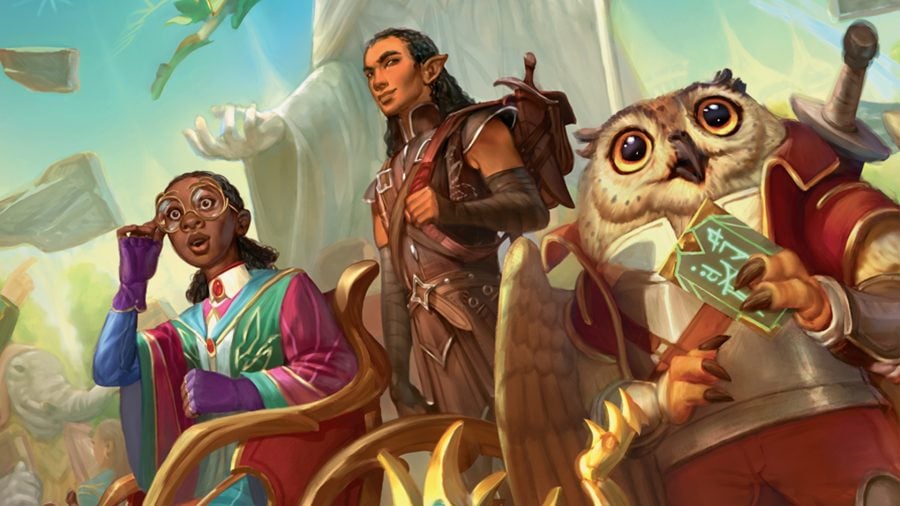What’s multiclassing in D&D 5E? Well, imagine this: you’re playing a Wizard and your party has angered a monster way above their challenge rating, so you throw up your best magical barrier spell. This stops it in its tracks long enough for your party to run, but, just as you’re about to make it, the beast grapples you and falls off a cliff.
In a falling grapple you have no ability to get to your spell components pouch – so what will you do now? Become a sad Wizard pancake? Or reveal that you’ve put more levels into fighter than wizard, and that you’re 100% ready to stab the Balrog up before you hit the bottom? Sometimes it pays to have a second skill set!
While playing two (or more) classes can be a lot of fun, there are also a lot of pitfalls. The greater flexibility gives you tools for ever more perilous situations – but also more options than ever before to create a potato character who flails uselessly while everyone else solves the adventure.
That’s why we’re here to explain the multiclassing rules, and draw attention to some of the strongest and weakest options D&D multiclass characters have available (If you’re comfortable with your grasp of the rules, skip to the 5E multiclassing and attributes section and start there).
D&D multiclass stats
| Class | Requirements | Proficiencies |
| Artificer | Intelligence 13 | Light & medium armour, shields, thieves & tinkers tools |
| Barbarian | Strength 13 | Shields, simple & martial weapons |
| Bard | Charisma 13 | Light armour, one skill, one instrument |
| Cleric | Wisdom 13 | Light & medium armour, shields. |
| Druid | Wisdom 13 | Light & medium armour, shields (no metal) |
| Fighter | Str or Dex 13 | Light & medium armour, shields, simple & martial weapons |
| Monk | Dex and Wis 13 | Simple weapons, shortswords |
| Paladin | Str and Cha 13 | Light & medium armour, shields, simple & martial weapons |
| Ranger | Dex and Wis 13 | Light & medium armour, shields, simple & martial weapons, one Ranger skill |
| Rogue | Dexterity 13 | Light armour, thieves tools, one Rogue skill |
| Sorcerer | Charisma 13 | Nothing! |
| Warlock | Charisma 13 | Light armour & simple weapons |
| Wizard | Intelligence 13 | Nothing! |
When you level up you can take a level in any class you meet the requirements for. Nothing stops you doing this more than once; you can have a 13th level character with 13 in every attribute that has 13 different classes.
The first time you gain a level in a class other than the one you started in, you gain the listed Proficiencies. These are instead of the Proficiencies usually gained at first level, and this list tends to be a lot shorter. The list is worth a look because it makes something clear: Order matters!
When choosing classes to multiclass into – order matters!
A Rogue who becomes a Paladin has more skills than a Paladin who becomes a Rogue (Since a Rogue starts with four, while a Paladin starts with two and only gains one from the multiclass). However, a Paladin who becomes a Rogue can use heavy armour, while a Rogue who becomes a Paladin only learns to use medium armour.
Another reason that order matters is that you automatically get maximum hit points on your first dice. A second level Barbarian Sorcerer will have 16 HP if they started as a Barbarian, but only 13 HP if they started as a Sorcerer.
Note that you tend not to gain many Proficiencies – so, if you’re building a first level character with the intention of multiclassing, consider what you want to be able to do. A Rogue who cannot sneak and pick pockets might not feel like the best 5E multiclass character.
If you’re running a Druid and you plan to multiclass into Rogue, you might want to make sure you pick up Stealth when picking your Druid skills to make sure that your character works the way you imagine it. In this case, I imagine that to be some sort of raccoon thief who comes in through the trash, loots a vault, and turns into an owl to escape.
5E multiclassing and Class Features
The class features of most multiclass characters just work; there’s no need to do anything special. When you gain a level in a class, you gain the hit dice for that class, as well as whatever features are associated with your new level in that class. Easy.
However, there are a few exceptions to look out for:
You may have noticed that, while each class lists their proficiency bonus at different levels, these are exactly the same for every class. A multiclass character gets to add their levels together and look on any table (again, they’re all the same) to determine their bonus.
Building blocks: Our full guide to the D&D 5E classes
You may also have noticed that the attribute advances are also the same for every class (though Fighter gets a couple of extra ones). That doesn’t matter, you only get the attribute bonuses as you qualify for them in an individual class. If you were dead set on never getting any stronger, you could keep multiclassing every time you hit third level and never improve your attributes.
This creates an important pressure on multiclass characters: You either need to accept that you will have lower attributes than the rest of the party – or you have to only multiclass into a new class when you hit level five, nine, 13, 17, or 20. Really only the first four, though; sticking with a class for 19 levels and then multiclassing out before getting your biggest, bestest final feature won’t get you the best multiclass 5E character you could build.
Class Features: will it stack?
Extra Attack
Extra Attack does not stack with Extra Attack. It also doesn’t stack with Thirsting Blade, which is just Extra Attack, but with a cooler name. For this reason, it’s usually not worth taking two different martial classes to level five.
Channel Divinity
Channel Divinity stacks, but it doesn’t stack well. You gain both sets of Channel Divinity abilities, but only get the uses per day from whichever class gives you more. You might be able to channel your divinity in more ways, but you’ll be able to do so no more than (and sometimes less than) a character who didn’t multiclass.
Unarmoured Defence
Unarmoured Defence doesn’t stack. In fact, technically you don’t even get the second Unarmoured Defence power you earn by levelling up. A lot of GMs would house rule that you can keep whichever one is best rather than whichever one you hit first, but you should check that your GM feels this way before committing to a character that’s counting on it.
Spellcasting
Warlock spellcasting is its own beast, and doesn’t interact with your class features from other classes. However, all other spellcasting stacks together into a glorious mess. You gain all of the spells known and spells memorised from both of your classes, as usual. Your spell slots are not added together, instead you add your levels together (classes with slow spellcasting like Rangers and Paladins contributing less than one level per level) and gain the slots available to a single classed caster of this level.
Magical Me: Read our guide to the best D&D 5E spells
Sharp eyed readers will have noticed the problem here. A multiclassed third level Cleric / third level Wizard has a ‘spells known’ list that only contains second level spells. However, they’ll have the slots of a sixth level character, which means they have some third level spell slots. The practical upshot of this is: If you plan on multiclassing some caster classes together, spells which do something extra when cast in a higher level spell slot just became your BFF.
5E multiclassing and Attributes
Most characters have a single attribute that they want to be as high as possible and increase every opportunity until it hits 20. For martial characters, this tends to be whichever one affects their attack rolls; for casters, it’s whichever one affects their save DC. In general, these start at +3 at firstt level and hit +5 by eighth. While a character might be a point behind because their race didn’t help their class, or because they really wanted a feat, they tend not to be much further behind than this.
It’s best to use classes that have the same primary attribute
Multiclass characters can make a mess of this, both by obtaining fewer attribute advances, and by requiring a wider spread of attributes. That can lead to a disappointing game, where your character can do awesome things in theory, but, in practice, is constantly missing or having spells fail to take effect. To avoid this, it’s best to combine classes that use the same attribute. For instance, it’s easier to combine a Paladin and a Sorcerer (both use Charisma for spells) than it is to combine a Ranger and a Wizard (one uses Wisdom, the other Intelligence).
It can be especially useful to use multiclassing to reduce the required statistic spread. For instance, a Fighter/Arcane Knight attacks on Strength and casts on Intelligence – but multiclassing into Artificer/Armourer for a few levels would allow both their attacks and spells to use Intelligence, making it easier to get by with fewer stat advances.
Your options for getting your attacks to use another statistic are:
- Artificer (Intelligence): the Battle Smith or Armourer archetypes.
- Bard (Charisma): the Shillelagh cantrip (made into a Bard spell via magical secrets)
- Druid (Wisdom): the Shillelagh cantrip.
- Paladin (Charisma): the Oath of Devotion (but only for one minute per rest).
- Warlock (Charisma): the Hexblade archetype.
Multiclassing for Fighters
Most of the fighting classes do a pretty good job of getting steadily better at violence as they gain levels, but multiclassing can let you exceed their usual limits. A few options to consider:
Expertise
A first level Rogue can double their proficiency bonus for a skill of their choice. This doesn’t have to be picking locks, it can be Athletics. Grappling, shoving, tripping and (if using the optional rule) disarming are all resolved by Athletics checks.
The best Rogue multiclass 5E option is possibly Barbarian. Their rage gives advantage on all Strength checks – so, combined with the Expertise bonus, they can be extremely difficult to escape. Their Unarmoured Defence feature is also very compatible with Stealth.
Do it yourself: Our guide to D&D homebrew gaming
A strict reading of the rules even allows a Barbarian to sneak attack an opponent they’ve grappled and tripped, since sneak attack requires the weapon to have the finesse property, but finesse weapons’ capacity to strike with Dex instead of Str is optional.
If anyone should question whether a raging berserker can aim for a vital spot, just shout “Go for the eyes, Boo!”
Hex/Hunter’s Mark
These first level spells allow you to deal bonus damage to an enemy each time you hit them. Dipping into Warlock or Ranger to acquire them can provide a noticeable damage kick to classes like Monk, which allow for a large number of light attacks.
Horde Breaker
A third level ranger (Hunter) can make an extra attack as part of their attack action, if it’s against a different target. This is not strictly an extra attack feature, so it does stack with other multiple hit abilities. Usually, a Fighter gains an extra attack every five levels, so if you’re trying to get as many attacks per action as soon as possible this is worth a look.
Fighting Style
A lot of martial classes get subtly different fighting style options. Don’t underestimate these; sometimes a permanent stat bonus that applies every round is worth more than a big flashy move you only get to do once per short rest. You cannot take the same one twice, but some are very compatible, such as increasing your own Armour class via defence and
making it difficult for enemies to target your allies using protection.
There are many more options, but the core principle is the same: Look for abilities that appear in the first few levels of another class that can add more to your attacks than another level in your existing class will.
Multiclassing for spellcasters
A lot of spellcaster multiclassing is about combining two distinct lists of D&D spells, trading off the power of their high level spells for the flexibility of being able to access the spells on both lists.
However, there are a few class features that might be worth fishing for as a caster:
Armour Proficiency
In previous editions, spellcasters were unable to wear armour, even if they gained Proficiency. In 5E multiclassing that’s no longer the case. If your Wizard is proficient in plate armour, then they can fly around chucking lightning bolts in it. A one-level dip (especially if it’s your first level) into a martial class can dramatically increase the survivability of your wizard.
Invoke Duplicity
Trickster Clerics of second level gain the ability to make an illusory copy of themselves and cast spells as though they were in its space. The Cleric spell list isn’t up to taking full advantage of casting spells from any location on the field without concern for personal safety, so it can be a fun one to access as a Wizard.
Smite Evil
An option for martially inclined casters. A twentieth level Paladin’s best spell slot is fifth level spell slots. An eighth level wizard / second level Paladin has sixth level slots. Smite Evil is based entirely on the level of the spell slot powering it, and not even slightly on how much effort you’ve put into being a Paladin. A multiclass Wizard who took evening classes s in Paladin smites harder than a dedicated Paladin of almost twice their level!
Other options for multiclass 5E characters
Some abilities directly enhance each other in a way that creates a whole that is more than the sum of its parts. They won’t necessarily lead to you being the best fighter or the most powerful caster, but allow you to achieve something that’s unusual, in order to create a unique character that’d be hard to get at without multiclassing.
It’s hard to point to individual abilities in this respect, but consider the types of combinations you can look for.
Focusing on one statistic
This approach consists of fishing in several classes to find as many ways to boost a given ability as possible. For example, a Paladin/Sorcerer can combine a defensive fighting style, shield, divine shield, and just picking up a regular lump-of-metal shield to hit ACs in the mid to high 20s while still fairly low level. Most monsters of this level will need natural 20s to dent your armour and, when they finally do, you can always Lay on Hands.
Two modifiers, one action
Alternatively, rather than stacking to get a high number, look for two things that modify how the same action works, and use them together. A Fighter/Rune Knight 3 can gain advantage on all sleight of hand checks. A Rogue/Thief 3 can make sleight of hand checks as a bonus action. Together, you have a character that can reliably pull a potion or wand off the belt of an opponent they’re fighting and use it in the same action. Or slip an immovable rod into their belt and turn it on. Or a decanter of endless water set to ‘geyser’. The sky’s the limit!
Two actions, one turn
Finally, you might look for a combination of actions that make up an excellent turn and seek to improve them both.
For example, consider these facts:
- A Monk can be good at grappling and gets bonus movement.
- A Druid can use longstrider to get more bonus movement.
- A Druid can wild shape into a creature that can fly.
- If you initiate a grapple, you can move up to half of your move distance taking the grappled person with you.
- You can end a grapple you initiate.
Generally, stacking a few movement bonuses doesn’t do much but if you want to make the classic ‘eagle vs turtle’ fighting style your own, being able to carry an enemy higher before releasing them to gravity’s sweet clutches, then the Monk Druid is the best 5E multiclassing option for you!
Multiclassing for Flavour
Not everything has to be about having the best statistics and destroying your GM’s carefully planned encounters in the most efficient fashion possible. You can multiclass just because it suits your character’s story, or because it’s cool.
If your character has an experience that causes them to convert to a religion during play, then perhaps taking a level of Cleric is right for their story, even if it isn’t right for their build.
Tomes aplenty: These are the best D&D books you should own
The flavour of two classes might also combine in a way that you find enjoyable. Perhaps you want to be a character that’s being slowly taken over by a parasitic fungus, and feel that a Druid/Spore Druid and Barbarian/Berserker combo is the best way to make that character.
Decisions like this add to the game, and can make sessions memorable in a way that just adding a really high number cannot. That said, you can make it hard for your GM to design challenging encounters if the same monster is a lethal threat to a story-built character, but a walkover to a strictly optimised one. So, work with your group to reach an agreement on ‘how far is too far’ both in terms of super-optimised multiclass builds and intentionally underwhelming choices.
Alternatives to multiclassing
Having a D&D multiclass character means keeping track of more abilities and doing more complicated things with your build. It also gives a greater opportunity to make a mess of things, since you’ll be deliberately skirting around all the streamlining in fifth edition that does a fairly good job of making it hard for a character to be outright bad at everything (as long as you invest in the suggested attributes). So, before committing to the best multiclass 5e character you can make, be sure to consider the alternatives:
Archetype
Does the thing you want exist as an archetype? Combining arcane and divine spells sounds great, but a multiclass Sorcerer/Cleric would just be a poor reflection of a divine soul – a Sorcerer archetype that already allows you to cast from both lists and doesn’t have to give up its most powerful spells to do it.
Race
Can you get the thing you want from multiclassing from your race instead? Dropping into Fighter for a level to pick up medium armour proficiency might seem like a good idea, but that can also be obtained through the dwarf or gith races.
Feat
Can you get the thing you want from multiclassing from a D&D feat? A fighter dipping warlock for hex might feel fantastic, with bonus damage on every attack and giving enemy disadvantage on a stat to make them easier to push around. However, you could also obtain hex from the Magic Initiate feat.
Flavour
Do you actually need the mechanical effects of the class or do you just like the flavour of it? Making a pact with a warlock patron might suit the story but it doesn’t mean you have to take a level of warlock. You could instead talk about how your first born child is guaranteed to enjoy great wealth or describe some other non-mechanical advantage of the deal to show why your character might strike a deal with the devil.
In D&D, multiclass characters do well when they are getting several things out of each class. A sorcerer multiclassing into paladin for martial weapon proficiency makes less sense than just taking a feat.
Roll up, roll up: These are the best D&D character creators online
However, going there because they want the armour proficiency and smite evil and shield proficiency and martial weapon use and a divine steed and the ability to sometimes combine charisma and strength for attack rolls… well in that case the multiclass is providing more than they could get for a feat alone.
But as always, you’re playing for fun. If your heart tells you that the best rogue multiclass 5E character is a paladin/rogue worshipping the god of thieves and executing a holy mission to steal everything that isn’t nailed down and then the nails and then the items previously known as items that were nailed down – do whatever makes you happy, efficient or not! Enjoy your hybrid monstrosities.
Source: Wargamer









